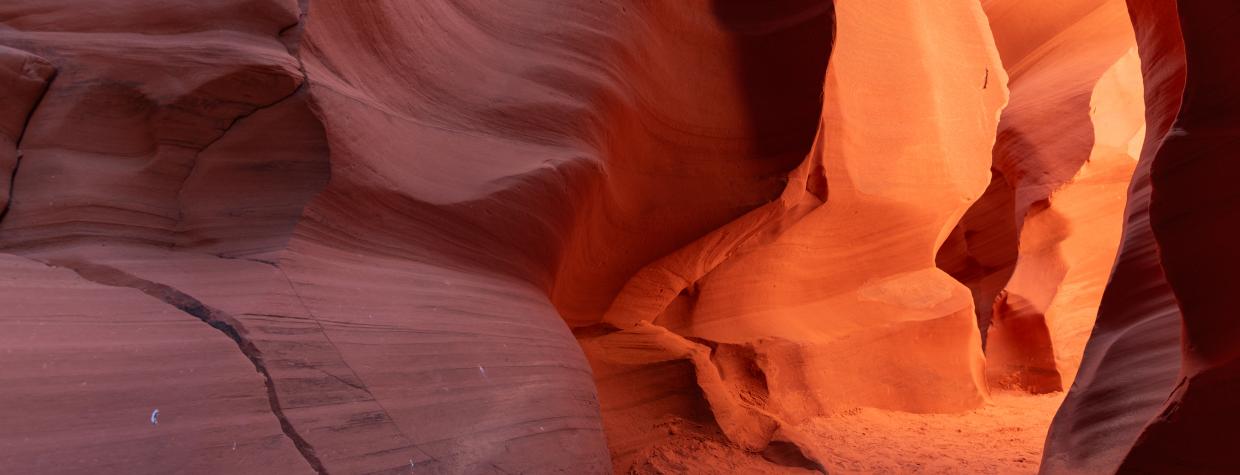Antelope Canyon — Arizona’s other “grand” canyon, located on the Navajo Nation near Page — is one of the state’s most visited and photographed natural wonders. The otherworldly vibrant oranges and reds of the slot canyon’s curved walls attract millions of visitors from around the world each year. Unlike other nearby Northern Arizona wonders, these slot canyons can be explored only with a Navajo guide.
Taadidiin Tours is one of 16 tour operators that offer walking tours of the canyon, and it’s the only tour operator for Cardiac Canyon and Antelope Canyon X. The company, founded by Rita Tadytin-Tsinigine in 2016, first began as a canopy-covered table with handwritten signage on the side of the road at Milepost 308 of State Route 98. In the company’s infancy, Tadytin-Tsinigine and her family members would shuttle visitors to and from Antelope Canyon in two old Chevy Suburbans. Nearly eight years later, Taadidiin Tours has grown exponentially, with more than 50 employees offering a range of tours including hiking tours of Cardiac Canyon and Antelope Canyon X, as well as photography tours.
The rich history of Taadidiin Tours and the Tadytin-Tsinigine family inhabiting and sharing the land extends far beyond 2016. The family has roots in the area as far back as the 1860s.
That decade, during the Long Walk, a mass deportation by the United States government in which 10,000 Diné were forcibly removed from their land, Tadidinii (“Taddy Tin”), Tadytin-Tsinigine’s great-grandfather, would hide people in slot canyons to avoid capture. From there, his son Clyde Tadytin made a permanent homestead at Antelope Canyon.
“My grandfather had told us when we were young that when he was a young boy, it was just him and his parents that lived in that area,” says Logan Tsinigine, Tadytin-Tsinigine’s son and the chief financial officer of Taadidiin Tours. “No one else had come, because Page was undeveloped. There was no dam yet; there was no power plant. And so it was just our family in the area, and that is the most northwestern part of the Navajo Nation. It was just kind of like the edge of nowhere.”
For years, Tsinigine says, family stories of the past were seldom shared or openly talked about among his relatives because of the devastation and sadness they experienced. More recently, Tsinigine and family members of the younger generation have encouraged elders to share their stories.
“History gets repeated when you don't know about your past,” Tsinigine says. “A lot of our younger people just have no idea. They don't know about the hardships and how hard life was. … We explain to the elders what's written about us and what is told. And they say, ‘No, that's not right.’ So, now they're starting to understand the importance of telling our side and getting it documented.”
With this information, the family is working on launching a new historical tour of Antelope Canyon, where visitors can view a map of places of cultural and historical significance to the Diné. Additionally, the family is the subject of a new documentary, Bad Indian: Hiding in Antelope Canyon, which aims to further share the untold side of history through the family’s lived experiences and multigenerational hardships while highlighting their resilience and cultural identity. The documentary was submitted to the 2024 Sundance Film Festival and other film festivals for consideration.
Through these offerings, the owners of Taadidiin Tours hope to highlight not only the beauty of Antelope Canyon, but also the history, people and sacred nature of the land.
“When we speak about the canyon in our tradition, it's a very sacred place,” Tsinigine says. “In modern society, if you look at a church or a temple, they're big and they're grand. When we look at historical sites or geographical sites, that's what we consider as our holy places. We have four sacred mountains, and the slot canyons are a sacred place as well. As of late, we're finding that more and more customers are wanting to learn about our history, our culture and about us as a people. We get to bring people from all around the world to these canyons and share that history and culture.”
Learn more about Taadidiin Tours or book a visit at AntelopeCanyon-x.com.

